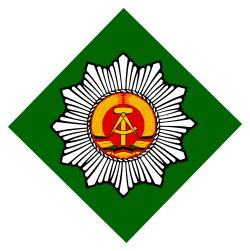Volkspolizei-Bereitschaft
The Volkspolizei-Bereitschaften (VPB, German for "People's Police Alert Units") were paramilitary police units of the German Democratic Republic (East Germany) from 1955 to 1990. The VPB were barracked units of the Volkspolizei for riot control and anti-insurgency with regiment status, under control of the Ministry of the Interior and considered part of the armed forces, but were never part of the National People's Army or the Ministry of National Defence. The VPB functioned as the de facto armed branch of the Ministry for State Security (Stasi), the secret police force of the German Democratic Republic.
| Volkspolizei-Bereitschaft | |
|---|---|
 Insignia of the Volkspolizei-Bereitschaft | |
| Active | April 1955 – October 1990 |
| Country | |
| Size | 12,000–15,000 |
| Part of | Volkspolizei |
| Garrison/HQ | East Berlin |
Organization
The German Democratic Republic's Ministry of the Interior (German: Ministerium des Innern, or MdI) maintained the independent Department of the Alert Units of the Volkspolizei (the country's main law enforcement agency) known as the Volkspolizei-Bereitschaften (VPB). It consisted of between 12,000 and 15,000 men (sources disagree) in 21 Volkspolizei Alert Units of battalion strength. There was usually one unit per district of East Germany, but the key districts of Halle, Leipzig and Magdeburg, with their large working class populations, and Potsdam all had two units. The Presidium of the People's Police in East Berlin had three units located in Basdorf.
Each Alert unit was organized as follows:
- Headquarters section
- Four alert companies:
- One mechanized company in wheeled armored personnel carriers
- Three motorized companies in trucks
- Support company
- Headquarters and staff company with:
- signals platoon
- engineer platoon
- chemical platoon
- reconnaissance platoon
- transport platoon
- supply platoon
- control section
- medical section
Equipment
These units were equipped with light and medium infantry weapons, SK-1 wheeled armoured personnel carriers, SK-2 water cannon (both armoured and unarmoured versions) and buses. Their uniform was the standard Volkspolizei grey-green. The political reliability of the Alert Units was of particular importance to the Socialist Unity Party of Germany (SED) as they would be used against the population in the event of social disorders such as the strike of 17 June 1953 in the industrial areas of East Germany.
See also
- Alert police
- Bereitschaftspolizei